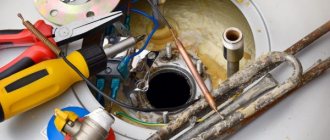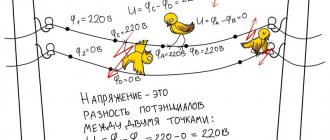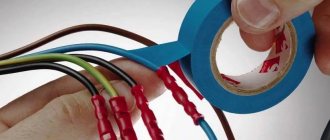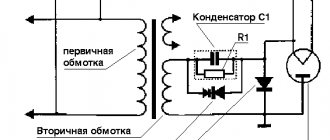Sometimes, when connecting equipment to a source of electricity, its body begins to “pinch.” Even if the discharge does not cause pain, such a malfunction should be corrected as soon as possible, since it may be a symptom of dangerous internal failures. The current strength is especially noticeable when we touch the unit with wet hands. Why does an electric stove shock?
If you encounter voltage on the surface of the electric stove, we strongly recommend that you contact a specialist for diagnostics by calling
8 (495) 228-39-35 or online. Service technicians work with refrigerators from the most popular brands: Gorenje, Indesit, Gefest, Zanussi, Hansa, Kaiser, Electrolux and others. We have been successfully repairing household appliances for more than 10 years, thanks to which all our technicians have gained enormous experience and have formed a base of regular customers. We work from 7:00 to 23:00 without weekends and holidays.
Other interesting questions and answers
Guest2
If you do not want to suffer electric shocks from the faucet, you will have to do the following:
- Replace all sockets in the kitchen, bathroom and toilet with special models with a moisture protection class of at least IP44 or IP54. They will protect you from accidental breakdown of the socket body.
- Examine the wiring with an ohmmeter or a hidden break detector. Increased resistance in the area or a detector signal will indicate the location of the breakdown.
- Replace all problem areas of the wiring, or even better, replace the entire line leading into the bathtub, kitchen or toilet, using a special, moisture-resistant cable.
- Call a technician and ask to replace the heating element on the washing machine, dishwasher, and also on the boiler. Unless, of course, the source of the problem is water heating electrical appliances.
We invite you to familiarize yourself with Thermoregulators with an air temperature sensor
Vladimir1
The reason that a stream of water produces an electric current may be the lack of grounding on a washing machine, water heater or other electrical appliance that is connected to an outlet in the bathroom/kitchen or is located next to it. This may also mean that the wiring is faulty, a wire is twisted somewhere, or the wires are damaged.
It happens that your neighbors have errors in the grounding of the water heating system, and an electric current is generated from the water from your tap. If you are sure that the problem is not in your apartment, then you need to look for neighbors who share a common riser to solve the problem. If in your bathroom or kitchen all the sockets and all the wiring are adapted to humidity, there are no problems with grounding and there is no damage to the electrical wiring and the appliances themselves, then contact the Housing Office/DUK to check the neighboring apartments for malfunctions.
There are no intersections, they just stand next to each other. Leaks too. It hits little by little, barely noticeable on small wounds on the hands.
Either there is bad grounding here or there. In addition, there is an insulation failure somewhere. Let’s say that in a washing machine the insulation in some place is not good enough and a “bridge” has formed, through which electricity flows to the body. If the grounding is connected incorrectly or is missing, but there is a small voltage on the case.
Water pipes, on the contrary, are well grounded and the resulting current goes into the ground. In this case, if you hold the washing machine with one hand and the water pipe with the other, then you are closing the electrical circuit. The wounds on the hand, as the most sensitive place, feel a small current.
https://www.youtube.com/watch?v=bsUquRqBD6M
This can be dangerous because in a damp room the effect of the current is only enhanced due to worse insulation. You need to take a device (for example an ammeter) and check where the problem is coming from. Of course, it may turn out that everything is fine with your washing machine, but a small current flows from the side of the water supply system through some faulty electrical appliance.
Sveta17082
So some smart guy made a grounding connection to the water pipe. Seryozha3
Malfunction of electrical appliances and heating elements
But most often, electric shocks are possible due to a malfunction of such simple household appliances as a washing machine, titanium boiler, instantaneous water heaters, or dishwasher.
If they do not have a protective grounding, any of them will sooner or later begin to electrocute. In this case, it is enough to simply plug them into the outlet and not even start them. And when you touch the surface of this device or just water, you will begin to “pinch” in a significant way.
If there is a small leak, a slight vibration of the device will be felt.
If the tap water itself is electrocuted (usually the pipes are plastic), then the cause is most likely damage to the water heating devices through which this same water flows.
Here all the blame lies with the heating element. Its insulation is destroyed, cracks appear, the heating coil is exposed and begins to come into direct contact with water. Hence the electric shocks.
If this is one small microcrack, then when the heating element heats up, it will open and the electric shock will be stronger. When the titanium is turned off, the heating element cools down and the crack seems to close, hiding the spiral. The tingling may be barely noticeable or disappear altogether. As the heating element deteriorates, the voltage on the tap water will remain constant.
To find out, you need to “ring” the heating element with an indicator screwdriver or a multimeter.
Moreover, it should be especially noted that water can be electrocuted even if the water heating devices of your neighbors, not yours, are faulty.
It's very easy to find out. Unplug the machine or plug from the heater socket and check for voltage. If it does not disappear, then go to your neighbors and ask them to do the same. When you turn off the power from a faulty water heater, the potential on the water pipes will also disappear.
Causes of malfunction
No grounding. According to technical requirements, the electric stove must be connected to a grounded outlet; it must have 3 wires: zero, phase and ground. The latter is needed just to protect you from electric shock. Modern houses usually have a ground electrode. But in Soviet-built buildings, the sockets are two-phase; there is no grounding factor. Insulation wear. The entire electrical network inside the device is built on wires and contacts
The most important thing here is that each element is isolated. To do this, all wires are covered with a layer of PVC. This is a fragile layer of plastic that can be damaged during transportation
And over time, the insulation itself may collapse. If a live wire comes into contact with metal parts of the system, voltage will be transferred to the housing. When touched with wet hands, you will feel a small shock. The heating element is broken. The heating elements are located in all heating parts: in the burners and oven (there are from 1 to 4 heaters). Any tubular electric heater consists of a conductive thread and an insulator around it, which transfers heat, but not current. If the insulating material is damaged, the electric stove will generate current and become hot even when it is turned off. Water got in. If the stove is located next to the sink or the soup often boils out of the pan, liquid can get inside the system and close the circuit on the metal body of the device. The good news is that the fluid can be removed and the system sealed. There are no serious holes inside the wiring. But if, after water gets in, when you turn on the burner, the plugs come out, you need to call a technician and check the entire structure. Electrical network defects. If you have dismissed all the previous reasons, but it is still easy to get a blow from the stove body, perhaps the fact is that the phase and neutral wires were mixed up when connecting. You won't be able to fix this on your own.
This is a fragile layer of plastic that can be damaged during transportation. And over time, the insulation itself may collapse. If a live wire comes into contact with metal parts of the system, voltage will be transferred to the housing. When touched with wet hands, you will feel a small shock. The heating element is broken. The heating elements are located in all heating parts: in the burners and oven (there are from 1 to 4 heaters). Any tubular electric heater consists of a conductive thread and an insulator around it, which transfers heat, but not current. If the insulating material is damaged, the electric stove will generate current and become hot even when it is turned off. Water got in. If the stove is located next to the sink or the soup often boils out of the pan, liquid can get inside the system and close the circuit on the metal body of the device. The good news is that the fluid can be removed and the system sealed. There are no serious holes inside the wiring. But if, after water gets in, when you turn on the burner, the plugs come out, you need to call a technician and check the entire structure. Electrical network defects. If you have dismissed all the previous reasons, but it is still easy to get a blow from the stove body, perhaps the fact is that the phase and neutral wires were mixed up when connecting. You won't be able to fix this on your own.
Possible causes of problems and ways to resolve them
Lack of grounding
Despite the fact that the design of the electric stove was initially designed in such a way as to eliminate any current leakage, voltage on the body can still occur. As a rule, current appears on the walls of the slab due to the lack of external grounding.
Each socket has outputs to three wires, which are called “zero”, “phase” and “ground”. There were no such standards in Soviet-built houses, so there is no grounding there. At the same time, in some modern houses there is grounding only according to documents, but in fact it is missing or does not work correctly.
The main causes of grounding problems:
intense ultraviolet radiation;
temperature too high;
oxidation of ground terminals;
To check the grounding loop, you need a multimeter, with which you need to find a wire with a phase in the socket, and then use the resistance measurement mode to determine whether the power supply is grounded. A phase on the housing may appear due to unreliable grounding contact between the electrical outlet and the stove's power cord plug. Remember: grounding problems should be handled by an electrician.
Isolation gap
One of the possible reasons for the appearance of current on the surface of the slab is broken insulation of wires and contacts. Its integrity can be checked with a tester. To do this, you need to “ring” all the contacts of the plug and all the panels of the case with an indicator screwdriver in order to localize the problem. This way you can check the voltage and determine which structural element requires replacement. Do not attempt to touch the surface of the stove under any circumstances unless it is insulated.
Breakdown of the heating element
The appearance of current on the stove body can be caused by an electric heating element in which a hole has appeared. In this case, it is necessary to turn off the power to the unit, call a technician and replace the heating element. The stove is the first structural element of the stove that begins to “pinch” if the heating system breaks down. If the electric stove generates electricity and the surface temperature rises even with the burners inactive, call a professional immediately.
Capacitor problems
The rarest reason for the appearance of a phase (operating voltage) is a malfunction of the capacitor that suppresses impulse noise. It is usually installed next to switching power supplies and power components. The current that escapes onto the housing from the capacitor is, as a rule, safe (less than 110 volts), but unpleasant sensations will certainly arise upon contact with it.
Shielding
If the floor on which the stove stands is equipped with a heating function, shielding may occur. In this case, it makes sense to remove the underfloor heating regulator and disconnect all conductors from it. After this, you need to find out the reason for the potential difference between the body of the electric stove and the floor heating elements.
Liquid
We all know that water is an excellent conductor of electricity. This knowledge can be useful to us when diagnosing problems associated with an electric stove. Sometimes liquid gets on metal contacts and conductors, closing a circuit on the case, which is why the latter receives an electric shock. The hand working with the stove should always be dry and clean to minimize the possibility of contamination of the device.
If your electric stove continues to shock you and your relatives, do not rush to throw it away and buy a new one, because, most likely, the problem can be solved. Before starting repairs, the most important thing is to localize the problem and determine the root cause of its occurrence, and not every owner can cope with this. One way or another, grounding the device and repairing the heating element are not the easiest tasks that should be performed by a professional.
It often happens that when you touch the body of a gas stove, a “tingling” sensation is felt. This is unpleasant, but the worst thing is that such minor troubles often develop into huge problems and breakdown of gas equipment. And no one needs such a development of the situation, right?
Why is the washing machine electrocuted, the main reasons
Lack of grounding
The main reason why electricity flows through the body of the washing machine is the lack of well-equipped grounding. Current leaks into the housing occur even with new household devices. Most often, this problem is faced by residents of high-rise buildings and Soviet-era buildings, in which the installation of grounding was not a prerequisite. It must be admitted that modern developers often avoid this issue, without burdening themselves with unnecessary expenses such as grounding equipment in a residential building.
Network interference filter
Almost all washing machines use so-called surge protectors (SFP), which are designed to protect the electronics of the washing unit from voltage surges. Due to the capacitors installed in them, the voltage during sudden surges is smoothed out.
This filter is located inside the washing machine and is attached to the unit body through a grounding wire, therefore, when voltage passes through this device, a small current will flow to the unit body due to the lack of grounding in the electrical network. The fact is that manufacturers assemble units, taking into account that users will have grounding in the network, which is very rare in Russia.
To avoid voltage on the housing, you need to disconnect and isolate the middle output (terminal) of the surge protector capacitor from the machine body, without disconnecting the ground wire from the unit body. In this simple way you can get rid of unpleasant electric shocks once and for all.
Wiring damage
The second cause of current leakage may be a malfunction of the electrical part of the washing unit. Damage to wires and contacts or “breakdown” of the heating element (heating element), which almost all washing machines are equipped with, can not only lead to failure of the entire electronic part of the unit, but also pose a serious threat to human life.
High humidity
The third reason for a breakdown on the housing is the operation of the washing unit in conditions of high humidity. Usually, when installing a washing machine in a bathroom, steam condenses on various parts. Water is an excellent conductor, and not only the body of the machine, but also the water supply and sewage systems can give an electric shock. In short, everything that comes into contact with the conductor, that is, water. In this case, even unsuspecting neighbors are exposed to the threat of electric shock.
Why does a gas stove burner burn poorly?
Interruptions in the operation of the burner are the most common problem when using a gas stove. Signs of its occurrence are a change in the shade of the fire that comes out of the burner, as well as a sharp increase or decrease in its value. The situation when the flame breaks off or some strange sounds appear is also not considered normal. Let us remind you that gas stoves are famous for their noiselessness.
Typically, any malfunction of the device is a consequence of a number of things. The most common reasons are:
- violation of the internal structure of the unit;
- damage to the gas hose;
- lack of gas fuel;
- low gas pressure;
- Incorrect burner selection.
The burner does not burn well and makes sounds
The burner is an integral part of any gas stove, a key working element needed for cooking. Externally, it is the end of a gas valve. The burner is involved in mixing and preparing the air-gas mixture required for normal functioning. It takes on maximum thermal loads. Over time, due to thermal effects, the components of this assembly are deformed, their fit to each other becomes loose. All these changes are reflected in the combustion mode - it is disrupted because air entering through the organized cracks interferes with the process. The flame goes out. The operation of the burner begins to be accompanied by the production of soot, and the color of the emerging flame becomes red. Another consequence is that the device generates inappropriate noise.
It should also be remembered that over time there is a gradual narrowing of the holes (nozzles). The reason is that with prolonged use, carbon deposits form (it is formed by food residues, household detergents, and fatty particles). A dirty burner can simply be washed thoroughly. If it is deformed, the solution should be an urgent replacement.
What to do on your own
If you cannot touch the device without feeling a tingling sensation, you should not try to fix it yourself without special tools and knowledge. But there are several mandatory things that you not only can, but should do:
- Turn off the electricity. This is an ironclad rule: if you feel a blow from the device, turn off the power supply through the shield. And then figure out what happened.
- Check whether water has spilled on the device. Inspect the equipment, check the outlet. There should be no water anywhere. Wipe all parts with a paper towel and dry all parts with a hairdryer if necessary.
- Remove the plug from the socket. This should be done when the entire apartment is de-energized. Otherwise, you can get a serious discharge. When the power to the stove is turned off, you can return electricity to the house.
Call a specialist. Even if you have an A in physics, you should not repair an electrical appliance without qualifications. At best, this will void your warranty; at worst, it will lead to irreparable damage to your equipment and even a fire. You should call the master from LenByt.
Can I fix it myself?
Any work with electricity is dangerous to human health and life. Therefore, all manipulations for connecting and repairing electric stoves must be carried out by craftsmen who have a special permit to work with electrical equipment.
When handling any electric stove, you must follow safety rules. To do this, you need to de-energize it, i.e. remove the plug from the socket. It is strictly forbidden to carry out any manipulations with the internal parts of the electric stove if it is turned on, especially if you are wearing wet clothes and shoes, barefoot or with wet hands.
In addition, if you decide to repair the stove yourself, you will need a special set of tools and spare parts for repairing electrical equipment. Not every owner has all the necessary tools. And also knowledge! An inexperienced person trying to repair something can cause even more damage to the equipment. And then the repair will be more complicated and cost much more.
Do-it-yourself electric stove repair
If a malfunction occurs, you can try to fix it yourself. But this solution seems beneficial only at first glance. Without experience and a special diagnostic tool, it is impossible to determine the exact cause of the device failure. Next, the problem arises with the selection of components and spare parts necessary for repair. Looking for them in specialized stores or on the Internet is a very time-consuming business.
While a service center specialist will quickly select all the parts for you and advise on the specifics of their operation. Statistics show that independent intervention in the vast majority of cases does not end as expected. In addition, there is a high probability of causing even greater damage to the equipment that was before. Therefore, we do not recommend that you take risks, and if you suspect a serious hardware failure, immediately seek help from specialists. The sooner the problem is fixed, the better.
Professional repair of household appliances
When you contact the service center, you get access to the highest level of restoration and warranty service in the capital region. We offer you the following terms of cooperation:
- A completely transparent budgeting scheme, pricing without markups.
- Use only original spare parts.
- A wide range of services provided, in addition to electric stoves, we repair gas equipment, washing machines, refrigerators, microwave ovens, sewing machines, you can call an electrician, plumber, or handyman for an hour.
- Masters of a high level of qualification and with extensive experience in the field.
- An integrated approach to solving problems with household appliances.
- Departure of craftsmen to any district of Moscow.
- Long warranty period of service.
- Models both currently popular and those already discontinued are accepted for repair.
- Repair at a time convenient for the customer.
You can order this service by phone, or by leaving a request directly on the website. The workshop hours are from 7 a.m. to 11 p.m. No weekends or holidays. All work is carried out in a short time frame, you can be 100% sure of the high quality of the services provided.
Why is there a spark, but the electric ignition does not work?
Perhaps this is a separate case that requires detailed consideration. After all, there are many reasons that can lead to electrical ignition failure. The first and most common cause is mechanical damage to the housing. If a crack appears on it, then most likely the spark strikes in a chaotic direction, but does not fall into the electrical ignition area. It is worth warning that the charger cannot be repaired, so if such a problem is discovered, you will have to purchase a completely new part. According to experts, for this reason the electric ignition on the Gorenye gas stove often does not work.
The stabilization of the working process can also be disrupted due to too high a pressure through which the gas is supplied. If the gas stove is “Hansa”, the electric ignition on it often does not work precisely for this reason. To eliminate the malfunction, you only need to find the optimal parameters and find the “golden mean”. Finally, it is recommended to check the condition of the nozzle. The fact is that often due to a malfunction of some components of the burner, the electric ignition on a gas stove does not work. Most likely, it is dirt or accumulated grease that is causing the damage. You can take regular wire and clean the burner. Of course, to carry out such events, it is best to contact a service center.
Why can the electric ignition of a gas stove click?
The causes of this malfunction can be very different, but all of them do not deserve special concern and, as a rule, are easily eliminated:
- If a clicking sound is heard after washing dishes or the stove, then the reason for its appearance is moisture that has entered the electric ignition. It causes the contacts to oxidize and close the circuit.
- Carbon deposits on the ignition button and subsequent sticking of the contact
- Overheating or breakdown of the button, leading to a short circuit of the entire circuit.
- The button malfunctions due to the accumulation of grease or dirt under it.
- Water gets into the auto-ignition switch.
- Violation of the rules for operating the stove.
- Problems associated with the functioning of the electrical panel responsible for supplying electricity to the room.
- No gas supply.
If all of the above reasons do not apply to the situation that has arisen, you should not carry out repairs yourself, since only a specialist can solve the problem in this case.
Theft of electricity or unscrupulous neighbors
The first and most common reason why people sin is unscrupulous neighbors. Suspicions immediately arise that they are trying to steal some electrical energy and save extra kilowatts. This may be caused by their major renovation work on the apartment and the heavy loads associated with this connection - welding machines, electric heat guns, etc.
Or in winter, when the temperature of the central heating batteries is insufficient, they very often begin to use powerful heaters and heaters. Naturally, you can try to connect all this by illegally throwing wires to the wiring in addition to the meter.
It’s true that neighbors may not always be deliberately to blame! Therefore, do not rush to immediately accuse them of stealing electricity.
In old houses with a TN-C grounding system, there is no separate grounding conductor. But many people lately still carry out wiring with three-core cables.
And on the one hand this is correct. The house will undergo reconstruction, the grounding system will change to TN-CS, and you will have everything ready. But until this moment, do not rush to connect such a conductor.
However, some, without waiting for reconstruction, simply use the risers of the nearest water supply as grounding conductors. And they immediately connect to it the very third grounding conductor. Which in turn is connected to the body of the electrical appliance.
And if the insulation of this device breaks through, then the phase will get through the pipes into the neighboring apartments.
How to get rid of electric shock in the kitchen between the sink and the electric stove?
How to get rid of electric shock in the kitchen between the sink and the electric stove (washer)? Email The stove is powered from a grounded socket, and the washing machine is powered from the same socket (with grounding). The pinching is equally unpleasant between the wet body of the washing machine and the sink, and between the wet stove and the sink.
Andrey86 wrote: The pinching is equally unpleasant between the wet body of the washer and the sink, and between the wet stove and the sink.
- First of all, you need to deal with the sink; first of all, it must be connected to a cold water pipe, or better yet, with a separate wire-strip-rod to a steel structure in the “riser” of the plumbing. just like it was done in old houses with a bath.
- If you have a newly built house, then even more so there should be a “standard” potential equalization system (PES) according to the project.
2 Valeryko It stings so much between. This means the Sink is better grounded. Old built house.
Andrey86 wrote: 2 Valeryko It stings so much between. This means the Sink is better grounded. Old built house.
- That is, there is voltage BETWEEN the sink and other GROUNDED electrical appliances
- this means the sink is less well grounded or not grounded at all
- If the house is of old construction, then the question is, is there grounding in the sockets? House with electric stove or gas?
Yes, connect the cases together with a wire and that’s it.
It’s not a fact whether it’s better or worse grounded. Just “different” lands. Equalize the potentials by connecting the housings together.
EWW wrote: It’s not a fact whether it’s better or worse grounded. Just “different” lands. Equalize the potentials by connecting the housings together.
- and - without understanding the source of the potential - also supply voltage to the neighbors in the pipes through the sink?
- after all, the bodies are already “aligned”:
Andrey86 wrote: Email. The stove is powered from a grounded socket, and the washing machine is powered from the same socket (with grounding).
Andrey86 wrote: Is there grounding in the sockets?
House without gas, cable to electrical outlet. plates of 3 wires, I changed the socket myself, the contact is reliable. Maybe the ground wire to the panel is broken? How to check?
2Andrey86 Take a probe screwdriver with neon and, standing on the floor and without holding on to anything, “poke” it into the sink, SM, stove.
Andrey86 wrote: Maybe the ground wire to the panel has a break? How to check?
Find the phase in the socket with a probe. Take a regular incandescent lamp in a socket with two wires. Holding both wires by securely insulated sections, insert one wire into the phase socket, the second - alternately into the neutral and ground sockets. In both cases, the lamp should glow at full intensity.
Regent wrote: Yes, connect the cases together with a wire and that’s it.
And start equalizing potentials “one for all, and all for one”? Then you need to stock up on thicker wires for your (D) SUP.
Again the concepts of grounding and grounding are confused.
Electric stoves are not grounded, but grounded.
And this conductor is screwed onto the same contact in the panel where the working zero (in an old-built house) is connected to the body of the panel (even better) with PE (the best option, but only in new buildings where the main line is five-wire).
And the sink is grounded, that is, it has contact with the ground through the water pipes. With real land.
In high-rise buildings, especially with single-phase electric stoves, phase imbalance often occurs. This means that potential appears at the working zero and, accordingly, the zero screwed there.
Try lighting a light bulb (12 volt halogen) between the protective ground of the electric stove and the cold water pipe.
If it lights up, then everything is correct.
azus6 wrote: But the sink is grounded, that is, it has contact with the ground through the water pipes. With real land.
All piping in the basement must be included in the SUP, which includes the PEN conductor. Must.
Should, but are not included.
And the author doesn’t have a PEN conductor at all.
It was in vain that they wrote before: “You cannot simultaneously grasp the body of an electric stove, a refrigerator, and a water tap with your hand.
In general, such a touch is ACCIDENTALLY possible ONLY in a small kitchen.
But for me, for example, even with my arms completely spread out, I can only reach from the stove to the sink if I really want to. And there is no tingling at all.
My stove is, of course, gas. Because I think that electric stoves suck. And all my relatives think so. We have lived our entire lives with GAS STOVES. Our kitchen is 10 sq.m.
The refrigerator is plugged into a BLACK socket.
We don't have a PEN conductor either. But this is not scary, because the house is 2-story, with electric heating, the electric furnaces are zeroed to the panel body, the main line is 4 wires.
The entrance to the apartment is single-phase. 16 amp lighting 16 amp outlets 25 amp electric heating
PET-2a electric furnaces instead of conventional batteries in the living room and bedroom. There is no heating in the kitchen, so I placed PET-2a on a piece of slate on the floor. And when it’s cold, I turn on the gas stove (oven)
We only reset the housings of electric ovens, and ONE outlet in the kitchen. All other wiring is two-wire.
Oh, by the way, I forgot to say.
We have a SUP, connected by a steel strip to the hot water and cold water pipes, the bathroom and in the bathroom, everything is connected to the SUP bus running vertically and welded to the reinforcement of the reinforced concrete foundation of the house.
azus6 wrote: We don’t have a PEN conductor either.
Like this? Do you have a 127/220V network?
azus6 wrote: The refrigerator is plugged into a BLACK socket.
The grounding is screwed onto the shield body.
And in the shield there are wires - phases.
And with zero, it’s generally interesting what’s been done - since there are only 8 apartments in the house (4 on the first floor and 4 on the second), then EACH APARTMENT has a separate ZERO from the electrical panel. Thus, a total of SEVEN are inserted into the shield. wires
I don’t know why this was done, maybe this is a feature for a house with electric heating, and a small apartment at that.
But the house, as already mentioned, is non-standard.
azus6 wrote: But the house, as already mentioned, is non-standard.
azus6 wrote: Again the concepts of grounding and grounding are confused.
Electric stoves are not grounded, but grounded.
Electric stoves are GROUNDED, otherwise the operation of stationary electric stoves should be immediately prohibited.
azus6 wrote: But the sink is grounded, that is, it has contact with the ground through the water pipes. With real land.
- and the sink is not grounded, since protective grounding is considered such only when connected to a special GROUNDING CONNECTOR and according to the design, after verification and appropriate execution of the act, and not at all by the fact of “contact with real earth”
azus6 wrote: In high-rise buildings, especially with single-phase electric stoves, there is often a phase imbalance. This means that potential appears at the working zero and, accordingly, the zero screwed there.
- We are apparently talking about old housing stock? So it was forbidden to use grounding there without grounding, so there will be no potential at the “grounding”
azus6 wrote: The grounding is screwed onto the body of the shield. And in the shield there are wires - phases. And with zero, it’s generally interesting what’s been done - since there are only 8 apartments in the house (4 on the first floor and 4 on the second), then EACH APARTMENT has a separate ZERO from the electrical panel. Thus, a total of SEVEN are inserted into the shield. wires I don’t know why this was done, maybe this is a feature for a house with electric heating, and a small apartment at that. But the house, as already mentioned, is non-standard.
Installation of protective equipment
When the water from the tap shocks in the apartment, most likely you will need to install protective automation in the bathroom, since in such places electric shock occurs more often than in other rooms. Experts do not recommend installing protective automation “with a reserve”. Circuit breakers should be set to the lowest power possible to ensure a minimum flow of electricity to the devices. So, the minimum leakage current should be about 10 mA.
If there is no grounding, it is necessary to install special equipment that will provide it. All electrical devices must be connected through an RCD, which will be triggered at the moment when the current leakage begins to be 10 mA or higher. Experts also recommend installing control systems that integrate equipment into a seamless communication network. This includes a bathtub, a sink, and other objects that could potentially conduct electric current. All these devices are connected to a single grounding bus. The SUP can be not only for one apartment, but also for the entire apartment building.
Sometimes the system that is designed for a house or entrance cannot cope with the load or there is none at all. That is why installing an EMS is the most common and effective option. It is worth understanding that such actions should be performed only with the help of specialists, since inept actions can lead to disastrous consequences. You shouldn’t skimp – it’s better to invest in experienced electricians who will have the necessary knowledge and skills. The craftsmen will do all the necessary work, thereby protecting the inhabitants of the house.
Ways to solve the problem
The operating instructions for almost any washing machine, from the Korean LG to the German Bosch, indicate the need to wipe the machine dry after each wash and leave the loading hatches open to dry the internal elements.
Unfortunately, many housewives only have enough time for such actions for a short time while the machine is new. In the future, moisture has a destructive effect on the electrical part of the unit and the insulation of the wires. Servicing your washing machine after each wash will not only extend its life, but will also significantly prevent current leakage to the body.
Grounding the washing machine
If the machine is used in a private home and there is no grounding, it must be equipped. When operating a washing unit in an apartment in an apartment building, there are two ways to prevent electric shock. Typically, apartments have two-wire wiring without protective grounding. However, there is a ground connection on the electrical panel body. In this case, you can invite a specialist from the housing office or another organization servicing the house and make a separate outlet directly from the electrical panel specifically for the washing machine. In this case, it is necessary to use a three-core cable with a grounding terminal on the shield and install a separate residual current circuit breaker.
Installation of protective shutdown
If the electrical panel also does not have grounding, the problem is solved by installing automation in the form of a residual current device (RCD). This device reacts even to minor electrical leaks and, when triggered, opens the electrical circuit, turning off the unit. An RCD cannot completely protect against electric shock, but it will definitely save lives.
The main parameter of such a protective device is the cutoff current. This is the current strength at which it turns off the device. For bathroom sockets, experts recommend installing an RCD with a cut-off current of 10 mA. The higher the risk of electric shock, the lower the cutoff current rating. For sockets in other rooms, a 30 mA automatic is suitable. A current of more than 100 mA is dangerous to human life.
You should not do the installation yourself; it is better to seek help from qualified electricians. Urgent repair of household appliances at home on the day of your call will be provided by RemonTekhnik. Competent craftsmen install an RCD after the residual current circuit breaker, and the operating current is selected to be greater than that of the circuit breaker. This is necessary so that if a short circuit occurs in the electrical network, the circuit breaker will trip earlier, protecting the RCD from burnout. Installing automatic shutdown devices in the distribution panel is not entirely convenient. When the device is triggered, you must constantly look into the panel to turn the washing unit back on. It is better to install a socket with a built-in RCD.
Another way to avoid electric shock is to install a primary and additional potential equalization system (EPS). The elements of this system are building structures, utility networks and a lightning rod system. In rooms with an increased risk of electric shock (bathrooms), additional systems are installed, consisting of a potential equalization box and conductors. It is better to entrust high-quality installation of all elements to professionals in this field.
If grounding is not provided?
For a multi-storey building (residential, non-residential), developers usually create a single grounding loop.
Residents of houses in which grounding is not provided should approach solving problems in the same way. When all electrical appliances in the house are grounded, the optimal level of fire safety will be achieved.
And the creation of a single outline in a multi-story building will facilitate its official design. This is an important point, because grounding can be operated legally only after permission has been given.
To do this you need to perform a series of actions:
- Creating a project.
- Coordination of the project with Rostechnadzor and the company that supplies electricity.
- Creating a ground loop.
- Checking the functionality of the structure, which must be carried out by representatives of energy supervision authorities.
If the house is large and the total power consumption of electricity exceeds 100 kW, then when changing the design you will have to obtain an admission certificate. This document is unlimited and allows you to operate household electrical equipment.
Individual grounding for an apartment
Now let’s figure out what to do if the gas stove suddenly starts giving an electric shock, and the owners of other rooms in the house do not want to take care of safety. In this case, you can get out of the situation yourself. Why do you need to create individual grounding?
The protective ground loop must be located in the ground. Since only soil makes it possible to instantly distribute any amount of electricity
But it should be remembered that “partisan” actions cannot be taken. That is, a metal bucket buried under the window is not the right solution. Since this will violate the provisions of a number of documents: Chapter 1.7 of the PUE, which takes into account the requirements for grounding conductors, and, possibly, the terms of the agreement between the management company and the electricity supplier. Therefore, the procedure for creating grounding should begin with coordination.
If there are no obstacles from other interested parties, then a project should be created and approved by Rostechnadzor. And then you can start working.
Which, as in the case of a general circuit for the entire building, should end with the invitation of specialists from energy supervision authorities to carry out an inspection.
The design shown in the photo allows you to distribute any amount of electricity in the ground, and safely. When manufacturing it, it should be taken into account that the width of the electrodes should not be less than 40 mm, and the thickness should not be less than 4 mm
What the protective circuit should be like is stated in the PUE. Chapter 1.7 of which indicates that it is made from a number of required elements:
- A single-core PE conductor used to drain electricity when it leaks. It is a copper or aluminum wire.
- Grounding bus . Such a device is usually placed on each floor of the building. The protective circuits of individual apartments and other premises are connected to the main bus.
- Electrodes and plates (made of metal conductive corners, pins) in the amount of 3 pieces. The pins are connected to each other by plates at an equal distance from each other. Then they are driven into the ground near the building.
All conductive parts of the structure must be insulated. This is done to prevent electric shock from direct or indirect contact.
If you live in a private house and not in an apartment, we recommend that you read the instructions for arranging a grounding loop in the house.
Wires used to create protection against electrical leakage must have:
- cross-sectional area is the same as that of a phase wire with a cross-section of up to 16 mm²;
- cross-sectional area is not less than 16 mm², if the same figure for the phase wire is within 16-35 mm²;
- cross-sectional area is not less than half that of the phase wire.
That is, if voltage is supplied to a gas stove that generates current through a wire with a cross-section of 4 mm², then this indicates that grounding should be made from a 4 mm² wire.
How to replace the protective circuit?
A way out for residents of a house without grounding can be to connect a gas stove that is experiencing electric current to an RCD or automatic circuit breaker.
The photo shows a residual current device (abbreviated as RCD) and a difavtomat, which can provide decent protection against leakage currents if the specification does not provide for a ground loop
These devices are also protective devices that can protect the user from electric shock during a leak and maintain the functionality of the gas stove, like any other equipment.
But the peculiarity of the RCD is that it de-energizes an apartment or other room only when the leakage is dangerous. That is, this device will save life, health and maintain the functionality of all electrical appliances, but it will not allow you to avoid “pinching”.
We recommend that you familiarize yourself with the connection diagrams of the RCD and differential circuit breaker, and the procedure for performing the work.
How to clean injectors?
One of the reasons is clogged injectors. Because of this, the gas pressure changes and the stove will smoke. Let's look at how to clean injectors. When working on gas stoves, the first step is to turn off the gas supply. You should also check to see if the stove is hot.
To clear the blockage, you will need to remove the divider and its cover. There will be a small hole inside. Use a sewing needle to carefully clean this hole; no effort is needed. It will be enough to rotate the needle tip in the hole.
If there is dirt, it will not hurt to clean the divider with the lid. To do this, you can use a toothbrush, dish gel, and warm water. Do not clean with a nail or wire. Modern burners are made of delicate materials and will not withstand such an act of vandalism. Next, wipe the burner dry and dry it. Then (after about half an hour) they are installed in place.
Tags: , machine, ampere, beat, boiler, sconce, view, water heater, harm, house, , grounding, sign, isolate, insulation, cable, like, kilowatt, capacitor, condensation, , installation, power, voltage, nominal, connection, potential, rule, wire, , work, regulator, repair, row, network, system, resistance, means, ten, current, , installation, phase, filter, shield, electricity, electrical panel
How to check the functionality of the lighter?
In order not to wastefully dismantle a potentially serviceable component, it is advisable to first check for a short circuit (short circuit).
This is easy to do with the help of a measuring device - a tester that supports the ability to measure resistance in the mOhm range.
Procedure for testing a lighter button for a short circuit using a classic electrical measuring instrument. Testing should be performed with the resistance measurement option in the “mOhm” range
On almost all models of gas stoves, ignition controls are connected by conductors through connectors. Therefore, each control element can be easily disconnected from the circuit for testing. After removing the plugs with conductors from the connectors, connect the tester probes to the released contacts of the button and monitor the readings on the scale.
If a short circuit has formed inside the button housing through the oxide junction, resistance measurements in the “mOhm” range will show some value in any case. When the device readings are equal to the absolute reference point (maximum resistance “mOhm”), there is no short circuit defect.
We also have other articles on our website about stove breakdowns and problems with burners:
Do-it-yourself gas stove repair: common malfunctions and ways to eliminate them Why is the gas burner noisy: analysis of the reasons + valuable recommendations for solving the problem Gas burner does not burn well: popular malfunctions and recommendations for eliminating them











